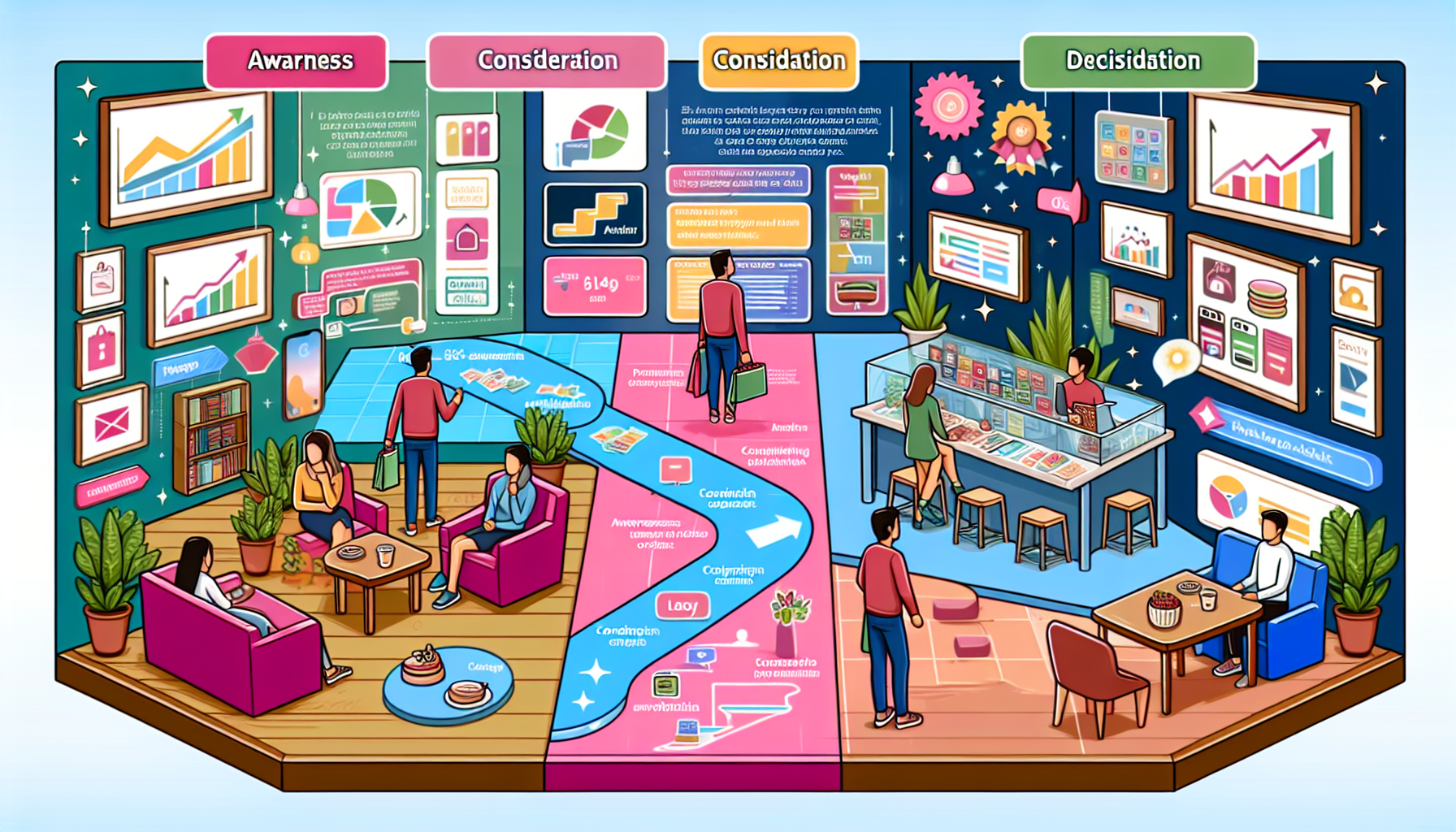Nurturing B2B buyers is essential for turning prospects into long-term customers, especially given the longer sales cycles and complex decision-making processes in B2B environments. In this article, we will explore effective strategies to engage and nurture B2B buyers at every stage of their journey, from generating leads to retaining loyal customers. You’ll discover actionable tactics to build relationships, increase trust, and drive higher conversions.
Key Takeaways
-
Understanding the B2B customer lifecycle is crucial for effective lead nurturing, as each stage requires tailored strategies to build relationships and foster loyalty.
-
Personalization and automation are key to successful lead nurturing campaigns; using data-driven insights helps marketers engage leads effectively and optimize conversion rates.
-
A multi-channel approach enhances engagement and leads to better results, effectively utilizing email, social media, SMS, and retargeting to reach leads where they are most active.
Understanding the B2B Customer Lifecycle

Navigating the B2B customer lifecycle is akin to steering a ship through varied waters. From generating initial interest to fostering loyalty, each stage requires a unique approach. Lead nurturing is paramount in this journey, as it builds relationships, loyalty, and trust with prospective customers, ultimately guiding them toward a purchase decision.
B2B transactions often involve longer sales cycles, multiple decision-makers, and complex products, necessitating a nuanced lead nurturing process. Understanding the needs and behaviors of buyers is crucial for effective lead nurturing, allowing marketers to provide relevant content that matches their journey.
The B2B customer lifecycle includes stages from generating interest in a product or service to nurturing leads until they become sales-ready. With a strategic approach, marketers can ensure that nurturing leads not only helps in converting prospects but also in retaining loyal customers.
Attracting Potential Leads
Attracting high-quality leads is the first step in the lead nurturing process. This is most effectively done through well-targeted campaigns and valuable content. Utilizing multiple channels and tactics, such as webinars, helps build authority and deepen relationships with potential leads.
A B2B lead magnet should focus on identifying buyer challenges, opportunities, or answering their questions. Artificial intelligence can significantly enhance lead targeting by analyzing data patterns to identify the most promising leads. By strategically employing these methods, you can capture and engage high-quality leads right from the start.
Remember, not every lead will be ready to buy immediately. It’s essential to create lead nurturing emails that keep your brand top of mind, provide value, and encourage further interaction until prospects are ready to make a purchase.
Converting Leads into Prospects
As leads advance through the sales cycle, the content shown to them must evolve to match their changing needs and interests. Personalized content becomes crucial at this stage, engaging leads more effectively and preparing them for the next steps in the sales funnel.
During the consideration stage, content should provide in-depth information that helps buyers select the right category of solution. This might include detailed guides or comparative analyses. The transition into the sales qualified lead stage indicates a lead’s readiness for direct sales engagement, making it vital to tailor your content to answer specific questions and showcase your solution’s benefits.
By focusing on creating relevant and personalized content, you can effectively convert leads into sales-qualified prospects who are ready for direct engagement with your sales team.
Retaining Loyal Customers
Post-purchase nurturing strategies are vital for enhancing customer satisfaction and loyalty. Acquiring a new customer is five times more costly than retaining an existing one. This statistic alone underscores the importance of nurturing your current customers.
Anniversary nurturing emails can encourage customer loyalty by making subscribers feel special. Offering a discount on subscription upgrades in these emails can act as an effective incentive. Post-purchase content should focus on delighting the customer and retaining their loyalty.
Additionally, personalized in-app popups can encourage repeat purchases and generate customer loyalty. By implementing these strategies, you ensure that your customers remain satisfied and loyal, thereby driving long-term business success.
Key Elements of a Successful Lead Nurturing Campaign

Creating a successful lead nurturing campaign involves several critical elements. Personalization should go beyond just including the recipient’s name; it must address individual concerns and preferences to be effective. Integrating advanced technologies into lead nurturing enhances personalization and engagement, which are crucial for sustaining lead interest.
Proper identification and segmentation of target prospects are essential for avoiding poor conversion outcomes in nurturing campaigns. Effective lead nurturing emails can result in 50% more sales-ready leads at a significantly lower cost, making automation a vital component.
Tailored content aligned with each stage of the buyer’s journey effectively engages potential leads and guides them through the purchasing process. Utilizing interactive content, such as quizzes and calculators, not only engages leads but also provides valuable data that refines future marketing strategies.
Personalization and Segmentation
Personalization in B2B lead nurturing is critical for building personal relationships, increasing engagement, and improving conversion rates. Tailoring content to reflect customers’ unique interests and needs is essential for effective lead nurturing. Segmenting leads helps serve tailored content to each group, significantly enhancing overall campaign performance and relevance.
Lead segmentation can lead to more meaningful interactions between marketers and their audience by ensuring content resonates with their profile. Buyer personas provide insights into different audience segments, enabling marketers to tailor offers and content effectively. Creating buyer personas is essential prior to defining the target audience for B2B campaigns, ensuring relevance in messaging.
AI technologies play a pivotal role in analyzing data patterns, allowing marketers to adjust nurturing campaigns according to individual lead behaviors and preferences. Advanced data analysis enhances the capacity to personalize content and improve the effectiveness of lead nurturing efforts.
Marketing Automation Tools
Marketing automation helps automate marketing processes, saves time, improves lead quality, and enables personalization. Using marketing automation can increase the volume of qualified leads by as much as 451%. Creating automated email sequences based on specific actions can enhance lead nurturing efforts.
Marketing automation tools streamline nurturing, send timely emails, schedule follow-ups, and deliver targeted content. These tools can share information on social media and convey messages to prospects effectively. Automation helps track leads and score them based on engagement and interest, focusing on qualified leads.
Automated workflows ensure consistent engagement and prevent leads from falling through the cracks. HubSpot, Marketo, and Salesforce Pardot are among the leading platforms designed specifically for B2B marketing automation. These platforms provide comprehensive solutions beyond just basic email tools.
AI can help automate personalized email nurturing campaigns, improving lead engagement. Automated lead scoring helps qualify prospects. This enables marketing to pass high-quality leads to the sales team.
Performance Tracking and Analysis
Key email metrics that should be monitored for optimization in lead nurturing include open rates, click-through rates, and conversions. Continuous monitoring, testing, and optimizing are essential for the effectiveness of lead nurturing processes. Optimal pathways and frequency of communication can significantly affect nurturing outcomes.
Successful case studies should focus on presenting measurable outcomes to illustrate the efficacy of the email nurturing campaign. Information included in case studies should detail the client’s problem, the solution provided, and measurable results. Continuous analysis of metrics and A/B tests can help improve lead nurturing outcomes.
Testing helps determine what resonates with different audiences and should include variables such as topics, subject lines, and timing. Identifying effective messages and optimal presentation timing can enhance the success of nurturing campaigns.
Leveraging lead scoring—considering factors like age, location, and behavior—can lead to more targeted and effective communications. Balancing content delivery is crucial to maintain lead interest without causing information fatigue.
Creating Effective Lead Nurturing Emails
Lead nurturing emails are designed to engage potential customers and move them along the sales funnel. Identifying a purpose when writing a lead nurturing email is crucial to create compelling content that resonates and drives conversion. Personalizing lead nurturing emails should be based on unique interests, behaviors, and the lead’s stage in the sales funnel.
Lead nurturing emails should provide valuable, targeted content that addresses the interests and pain points of the leads. Including testimonials or success stories can enhance the credibility of a lead nurturing email campaign, helping to build trust. Here are some lead nurturing examples to consider.
Engaging content often includes eye-catching visuals that capture the reader’s attention and retain their interest. Including testimonials can take various forms, such as short statements or comprehensive, story-based case studies.
Addressing Pain Points
Identifying and addressing customer pain points is crucial for enhancing engagement in lead nurturing emails. Engaging emails tailored to pain points can significantly increase customer response and improve retention rates. Addressing potential pain points in lead nurturing emails is essential for engaging the audience.
In the awareness stage, content should primarily focus on addressing pain points and providing educational resources. For example, an intro email from Tuft & Needle addresses the difficulty of making a decision when buying a mattress online. This approach helps build a connection with leads by showing empathy and understanding their challenges.
Using Clear CTAs
Every lead nurturing email should contain a clear and purposeful call-to-action to guide the reader’s next steps. A good CTA should be prominent, unambiguous, and aligned with email goals.
When crafting a CTA, consider what action you want the reader to take after reading the email. This clarity helps drive engagement and conversions by providing a clear path forward.
Maintaining Brand Consistency
Lead nurturing emails should align with your overall brand to create a cohesive experience. Consistency in visuals and messaging across lead nurturing emails helps build trust and enhance brand recognition.
For instance, Headspace uses a specific combination of color palettes, black and green, in its email surveys for visual identity. This consistency ensures that every interaction with your brand reinforces your identity and values.
Developing Content for Each Stage of the Buyer’s Journey

The buyer’s journey is a roadmap from awareness to decision-making. It is crucial to develop content tailored to each stage to effectively guide leads through the marketing funnel. Nurturing leads from awareness to decision-making is essential for converting them into loyal customers. Creating offers for each stage helps guide leads down the marketing funnel.
Effective content at each stage enhances engagement and supports informed decision-making. By providing relevant and valuable content at the right time, you can nurture leads more effectively and encourage them to move forward in their buying process.
Awareness Stage Content
In the awareness stage, content should attract the community and capture leads. Blog posts, articles, infographics, and videos are essential types of content for B2B lead nurturing. Suitable offers for this stage include checklists, quizzes, guides, workbooks, or assessments.
Awareness stage content should be visually appealing, professional, and provide added value. This content helps potential leads understand their challenges and opportunities, positioning your brand as a valuable resource.
Consideration Stage Content
During the consideration stage, potential buyers look for in-depth comparisons and analyses of various solutions. Content types for this stage should include case studies, product comparison guides, and free samples. Creating detailed guides helps prospects evaluate their options by providing comprehensive information about various solutions.
These content types facilitate informed decision-making for prospects, aiding them in their evaluation process. By providing valuable insights, you help potential buyers make more educated decisions and move closer to a purchase.
Decision Stage Content
At the decision stage, prospects are ready to evaluate specific vendors and need information that helps finalize their choice. Effective content for this stage can include free trials, consultations, and promotional offers to encourage conversions. Offering demos showcases product benefits and features, aiding prospects in making informed decisions.
The ultimate aim of providing this content is to facilitate the conversion of leads into customers. By offering practical and persuasive content, you can help prospects take the final step toward purchasing your product or service.
Leveraging Multi-Channel Nurturing Campaigns

Utilizing a multi-channel strategy enhances engagement by allowing communication across email, social media, SMS, and retargeting. Maintaining consistent messaging is essential for effective multi-channel lead nurturing, ensuring that potential leads receive a cohesive experience. A successful multi-channel lead nurturing strategy should include email, social media, webinars, and direct calls.
By leveraging multiple channels, you can reach leads where they are most active and provide a more comprehensive nurturing experience. This approach increases your chances of engaging leads and guiding them through the sales funnel effectively.
Social Media Engagement
Engaging followers on social media can significantly increase lead generation, with 68% of marketers affirming its effectiveness. LinkedIn and Twitter are identified as effective tools for engaging potential clients. To enhance engagement with followers on social media, share useful content, engage with followers, and run targeted advertising campaigns.
Ideal channels for distributing awareness stage content include blogging, social media, and search engine marketing. By actively engaging on social media, you can attract and nurture leads effectively.
SMS Campaigns
SMS campaigns typically see open rates as high as 98%, making them an effective channel for direct communication. SMS campaigns provide timely and direct communication, making them a valuable tool for engaging leads.
By incorporating SMS into your lead nurturing strategy, you can ensure that your messages are seen and acted upon promptly, increasing engagement and conversions.
Retargeting Ads
Retargeting ads are used to remind users of your brand or product after they’ve visited your website without taking action. The purpose of retargeting ads is to target individuals who have previously engaged with the brand. The average click-through rate (CTR) of a retargeting ad is 10 times higher than a regular display ad.
Retargeting ads can be used on platforms like Google Ads. They can also be implemented on various social media platforms. Dynamic retargeting ads provide personalized content based on users’ previous interactions with the brand or products.
Aligning Marketing and Sales Teams
Collaboration between sales and marketing is essential to provide a unified customer experience and enhance lead quality. Successful lead handoff relies on clear communication and shared objectives between marketing and sales.
B2B lead nurturing often requires comprehensive marketing strategies due to longer sales cycles and the need for relationship building. By aligning marketing and sales teams, you can ensure a cohesive strategy that enhances lead qualification and boosts revenue.
Data Sharing and Communication
Sharing insights between sales and marketing fosters a better understanding of customer needs, improving lead nurturing effectiveness. Implementing a structured approach to data sharing enhances collaboration and minimizes misunderstandings.
Integrating marketing automation with CRM systems enhances lead nurturing by providing deeper insights into lead behavior and preferences. By fostering open communication and data sharing, both teams can work more effectively towards common goals.
Joint Strategy Sessions
Regular strategy sessions between sales and the marketing team help align their goals and tactics, enhancing overall campaign effectiveness. These sessions ensure that both teams are synchronized in their efforts and can adjust tactics based on shared insights.
Conducting regular strategy sessions fosters improved collaboration, leading to more effective marketing and sales initiatives. This alignment is crucial for creating targeted campaigns that drive results.
Case Studies and Success Stories
Case studies showcase success stories that can convince potential customers about the effectiveness of a product or service. Effective case studies should demonstrate how products or services can solve the problems of potential customers.
The focus of case studies should align with the needs and interests of the target audience to ensure relevance. Implementing lead nurturing best practices can maximize sales and enhance customer engagement. Companies utilizing marketing automation for lead nurturing have seen a 451% increase in qualified lead volume.
The Role of Marketing Automation Platforms
Marketing automation platforms play a critical role in helping businesses streamline their lead nurturing processes by automating repetitive tasks, allowing marketing teams to focus on strategic initiatives. Drip campaigns are automated emails sent over time to educate and persuade leads, making the nurturing process more efficient and improving conversion rates.
Chatbots provide customer support and deliver customized recommendations, enhancing customer engagement through real-time assistance. The future of B2B lead nurturing will increasingly rely on AI-driven strategies and emerging technologies, which will optimize conversion rates and enhance lead qualification.
Popular Platforms Overview
HubSpot is known for its user-friendly interface and robust marketing automation features that cater to various aspects of lead nurturing and management. Idea Grove has been a HubSpot Platinum Partner for more than a decade.
Pardot is particularly effective when integrated with Salesforce, offering seamless data synchronization and marketing message automation. Marketo provides advanced marketing automation capabilities, particularly for businesses focusing on lead management and multi-channel marketing. These platforms offer comprehensive solutions that streamline lead nurturing and enhance overall campaign effectiveness.
Features and Benefits
Marketo allows for the creation of Smart Campaigns, which facilitate automated nurturing and list management. Pardot’s Engagement Studio enables users to design personalized marketing journeys, enhancing lead nurturing experiences.
HubSpot features a user-friendly drag-and-drop email editor, making email design accessible even for those without technical skills. Pardot includes built-in Litmus testing for emails, allowing marketers to preview how their messages will appear on various devices.
Key features of marketing automation platforms include lead capture, campaign management, and detailed analytics to evaluate performance. Utilizing machine learning allows companies to automate repetitive tasks in lead nurturing, thus increasing operational efficiency.
Marketing automation platforms revolutionize B2B lead nurturing by providing essential tools for tracking, engaging, and converting leads into sales-ready prospects.
Common Mistakes to Avoid in Lead Nurturing
Personalization in lead nurturing significantly increases email engagement metrics such as open rates and conversion rates. A robust content marketing strategy allows brands to nurture leads effectively without constant intervention from the sales team. Maintaining brand consistency in lead nurturing communications builds trust and credibility with leads.
Ongoing experimentation and analysis are crucial for optimizing lead nurturing efforts and improving campaign performance. By avoiding common pitfalls, you can enhance the effectiveness of your lead nurturing campaigns and drive better results.
Overloading Leads with Information
Successful lead nurturing can be difficult due to the numerous types of emails to send, creating uncertainty about where to begin. Overloading leads with information can overwhelm them and reduce engagement.
Instead, focus on providing concise, valuable content that addresses their specific needs and interests.
Ignoring Lead Feedback
Listening to lead feedback is vital for refining nurturing strategies and enhancing overall effectiveness. Overlooking feedback can result in missed opportunities and decreased engagement. By actively seeking and incorporating feedback, you can tailor your campaigns to better meet the needs of your leads.
Lack of Follow-Up
Consistent follow-up is crucial for keeping leads engaged and guiding them through the sales funnel. Failure to follow up with leads can result in missed sales opportunities, as many interested leads are not consistently nurtured.
Marketing automation can lead to a significant boost in sales productivity and a reduction in marketing costs. Regular follow-up, enhanced by automation, not only improves lead engagement but also increases overall sales conversion rates.
Future Trends in B2B Lead Nurturing

AI and machine learning are being increasingly utilized to personalize and optimize lead nurturing campaigns, making them more effective at targeting individual leads. Predictive analytics is becoming a key tool for anticipating lead behavior, allowing marketers to tailor their nurturing efforts based on data-driven insights.
The use of interactive content, such as quizzes and calculators, is on the rise as it engages and helps qualify leads, providing a more personalized experience. By staying ahead of these trends, businesses can enhance their lead nurturing strategies and drive better results.
AI and Machine Learning
AI and machine learning technologies play a significant role in enhancing personalization in lead nurturing campaigns. Effective data sharing between sales and marketing teams streamlines processes and enhances the overall buyer experience. The integration of AI-driven insights can optimize the engagement of potential leads throughout their buying journey.
Adopting AI, machine learning, and effective data sharing ultimately leads to more personalized and successful lead nurturing campaigns. By leveraging these technologies, businesses can stay ahead of the competition and deliver more relevant experiences to their leads.
Predictive Analytics
Predictive analytics is a powerful tool that allows businesses to anticipate lead behavior and improve their nurturing efforts. By utilizing predictive analytics, businesses can forecast lead behaviors, which informs their nurturing tactics.
Tailoring nurturing strategies based on predicted behaviors enables businesses to engage leads more effectively. Integrating predictive analytics into lead nurturing not only enhances personalization but also optimizes engagement and conversion rates.
Interactive Content
Building interactive quizzes or calculators offers personalized results or recommendations, making them effective tools for nurturing leads. The Close, a real estate marketing website, effectively utilized an interactive quiz to nurture leads and engage its audience.
Interactive quizzes assist leads in decision-making by guiding them to the right product based on their responses, thereby enhancing their overall experience. Using interactive content like quizzes and calculators can significantly enhance engagement and qualification of leads.
Summary
Mastering the art of lead nurturing is essential for driving conversions and building long-term customer relationships. By understanding the B2B customer lifecycle, leveraging key elements of successful campaigns, and staying ahead of future trends, you can create effective lead nurturing strategies that engage and convert prospects. Remember, the journey from lead to loyal customer is a marathon, not a sprint. Implement these strategies, monitor your performance, and continuously optimize your approach to achieve the best results.
Frequently Asked Questions
What is lead nurturing in B2B marketing?
Lead nurturing in B2B marketing is all about building meaningful relationships with potential customers by delivering personalized content that meets their needs and helps them navigate the sales funnel. It's a smart way to guide prospects to a decision!
Why is personalization important in lead nurturing emails?
Personalization is crucial in lead nurturing emails because it boosts engagement by tailoring content to the recipient's specific interests and needs, making it much more relevant and appealing. When you address individual concerns, you create a stronger connection that drives action.
How can marketing automation tools help in lead nurturing?
Marketing automation tools can significantly enhance your lead nurturing by automating routine tasks, enabling you to send timely emails, schedule follow-ups, and deliver personalized content based on how leads interact with your brand. This means you can build stronger relationships with potential customers more efficiently!
What are some common mistakes to avoid in lead nurturing?
To keep your lead nurturing effective, avoid overwhelming them with too much information and make sure to consistently follow up. Ignoring their feedback can also hinder your chances of building a relationship and converting them.
What are some future trends in B2B lead nurturing?
Expect to see a rise in AI and machine learning for more personalized experiences, along with predictive analytics that can anticipate lead behavior. Engaging leads through interactive content will also become a key strategy in B2B lead nurturing.

 19 min read
19 min read




 14 min read
14 min read

